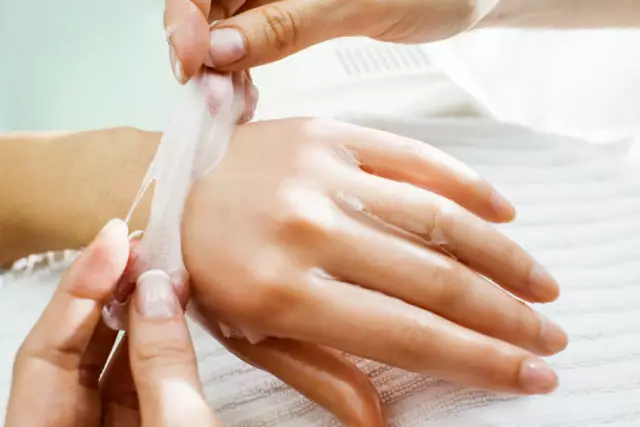- Author Rachel Wainwright [email protected].
- Public 2023-12-15 07:39.
- Last modified 2025-11-02 20:14.
Warts in children
The content of the article:
- Causes and risk factors
- Forms of the disease
-
Symptoms
- Common warts
- Flat warts
- Plantar warts
- Genital warts (condylomas)
- Laryngeal papillomatosis
- Diagnostics
- Treatment of warts in children
- Possible complications and consequences
- Forecast
- Prevention
Warts in children are a common dermatological disease of predominantly viral etiology, which is characterized by the appearance of small rounded neoplasms on the skin. Warts in children are prone to spread, rapid growth, and recurrence. When trying to self-medicate, it can become painful, scars and scars may appear at the site of the neoplasm.
The disease is recorded in all age groups, but is most often diagnosed in childhood and adolescence. In about 25% of all cases, warts in children spontaneously disappear within six months, and in 75% of patients, independent resolution of warts occurs within two years.
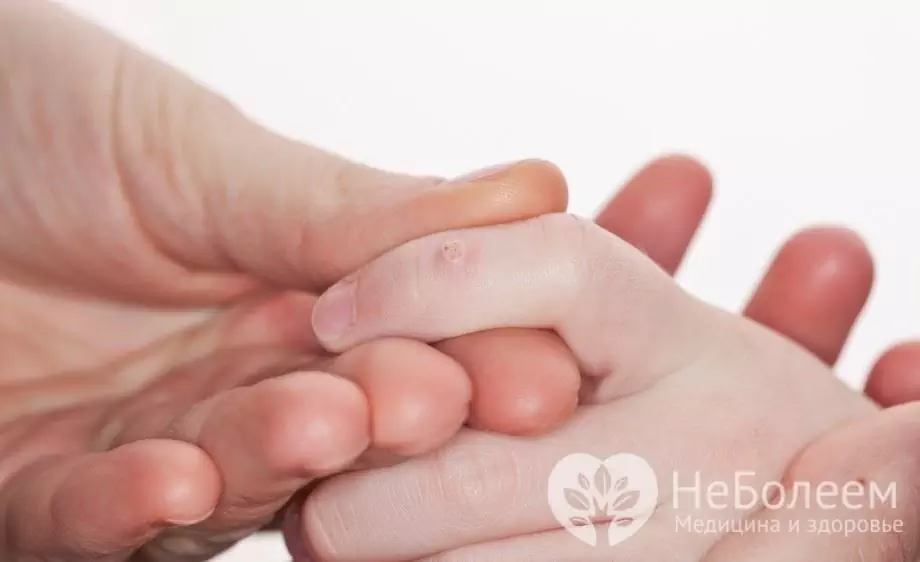
In children, warts tend to grow and spread rapidly.
Causes and risk factors
The causative agent of warts in children is the human papillomavirus, which is extremely widespread (according to some reports, it infects up to 90% of all people) and is capable of affecting both the skin and mucous membranes, provoking the development of skin neoplasms - papillomas, condylomas, warts (various strains of the virus cause certain types of damage). Infection with the virus occurs most often due to contact with an infected person, and children also often become infected through contaminated household items (toys, clothes, common items). There is also autoinoculation, that is, self-infection with a virus, which can be observed, for example, with the habit of biting fingers or biting nails. In addition, human papillomavirus infection can occur when a child passes through the birth canal.
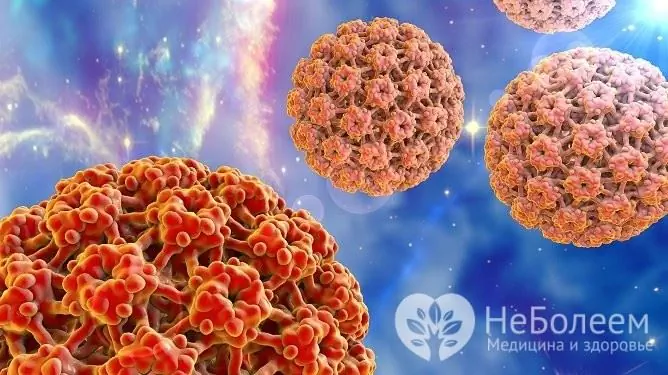
The causative agent of warts in children is the human papillomavirus
Human papillomaviruses belong to the papillomavirus family, which includes 27 species and more than 170 strains (types). The virion has no shell; its size is 50-55 nm. The virus replicates in the nuclei of the host's cells. The types and subtypes of human papillomavirus are determined by the degree of homology of the polynucleotide sequence, while the DNA of each type is homologous to the DNA of other viruses of this class by at least 50%. More than 40 types of human papillomavirus can cause warts in children.
Risk factors for the development of the disease include immunodeficiency states, mental stress, insufficient adherence to the rules of personal hygiene, increased sweating of the skin of the hands and feet. At risk are children who visit swimming pools, children's sports clubs, baths, preschool institutions.
Forms of the disease
Warts in children are of the following forms:
- ordinary (simple, vulgar) - prevail in the general structure of warts, they are most often found in children and adolescents;
- plantar warts;
- flat (youthful, juvenile) - usually found in children over 10 years old;
- genital warts (condylomas) are rare in childhood;
- papillomatosis of the larynx is another rare form of wart lesions, characterized by the growth of warts (papillomas) on the mucous membrane of the larynx.
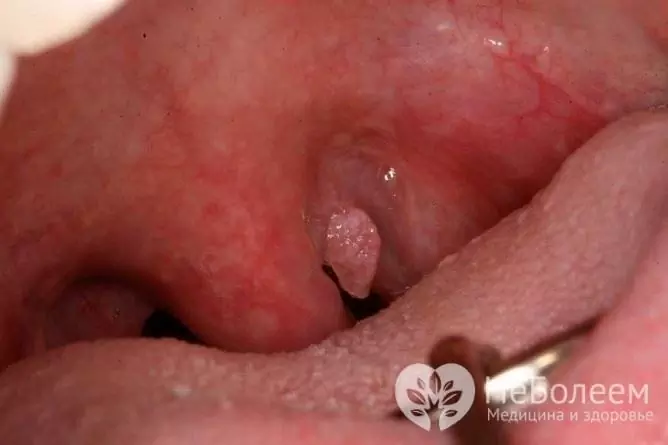
A rather rare form of wart lesion - laryngeal papillomatosis
Symptoms
The incubation period for human papillomavirus infection is from one to five months, however, even after this period, the child may not develop any clinical manifestations of the pathological process (asymptomatic virus carrier).
The clinical picture of warts in children depends on the form of the disease.
Common warts
The most common, common warts are small (3-10 mm in diameter) dense, non-inflamed neoplasms that are rough to the touch, which, if not injured, are painless. Small neoplasms have the color of the skin, warts of larger sizes can take on a dirty gray tint. Sometimes neoplasms merge with each other, forming plaques. Simple warts are located on the palms, fingers, the back of the hand, in more rare cases, on the face, mucous membranes. A rare subungual form of common warts in a child's hands can cause deformation of the nails.
Flat warts
Unlike ordinary warts, flat ones are less visible on the skin and are small (0.5-3 mm) rounded neoplasms with a smooth surface. Usually flat warts in children are located on the skin of the face, neck, chest, back of the hand, flexion surfaces of the forearms, legs. Often, flat warts are multiple, grouped, can affect large areas of the skin, but never merge with each other.
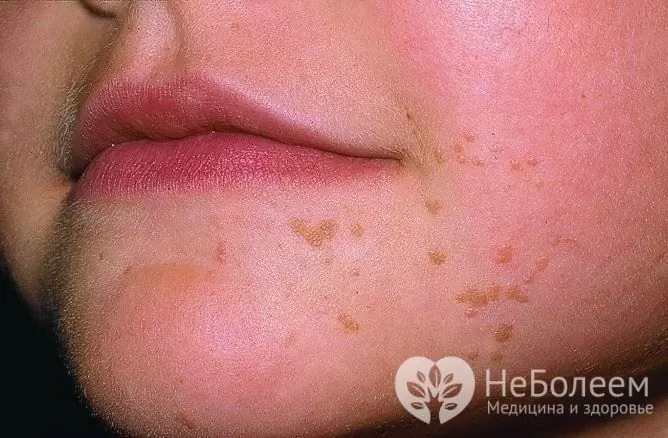
Flat warts are less noticeable on the surface of the skin than regular warts
Plantar warts
Plantar warts in children look like rounded hyperkeratotic formations on the soles, can be single or multiple, have a yellowish-brown color, rise above the skin, resembling a callus. A dark pattern of thrombosed capillaries is visible on the surface of the plantar warts. A wart on a child's leg is easily injured (by friction, shoe pressure), in this case it becomes painful and may bleed.
Genital warts (condylomas)
Genital warts in children are localized in the nasolabial folds, have a lobed structure and a smooth white-pink or bright red surface, as well as a narrowing at the base. When injured, genital warts on the child's face bleed easily, around the neoplasm, the skin around them becomes hyperemic. Genital warts are prone to the formation of large conglomerates.
Laryngeal papillomatosis
Laryngeal papillomatosis is rare and is usually diagnosed in preschool children (age group from one and a half to five years). Often the appearance of papillomatosis of the larynx is preceded by acute respiratory infections. Neoplasms can be single or numerous, in severe cases they can lead to the development of a life-threatening child's obstruction of the airways. The main symptom is hoarseness, which increases over time and can turn into aphonia. Later, as the warts grow, breathing disorders join.
Diagnostics
In most cases, an examination is sufficient to diagnose warts in children.
If necessary, identification of the pathogen is carried out by examining scrapings from the affected area using the polymerase chain reaction method. The type of virus is determined using the method of molecular hybridization of nucleic acids.
With the development of persistent or atypical forms of warts, a biopsy may be required, followed by histological examination of the material obtained.
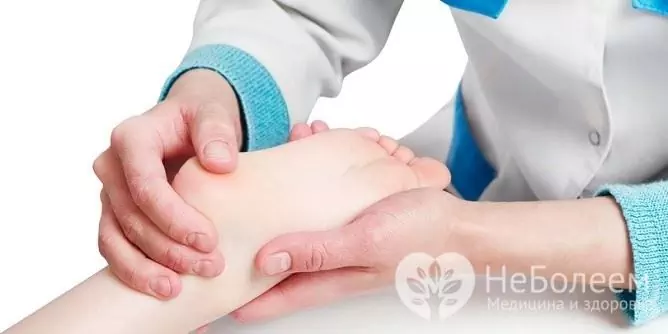
In most cases, an external examination is sufficient to diagnose warts in children.
To diagnose papillomatosis of the larynx, they resort to direct (in preschoolers) or indirect laryngoscopy.
Differential diagnosis is carried out with abrasions and calluses, lichen planus, warty tuberculosis of the skin, plantar papules with syphilis.
Treatment of warts in children
In most cases, uncomplicated forms of simple warts do not require special treatment; expectant tactics are justified. In ¼ of patients, self-resolution of vulgar warts occurs within one month, in the rest - in the period from three months to one and a half years. Youthful warts also go away on their own after the completion of hormonal changes in the body. After recovery, no trace remains on the affected area.
Treatment requires warts that are often traumatic, as well as those that are not prone to self-healing.
In some cases, a method is used to remove warts in children using keratolytic agents in the form of an ointment or patch.
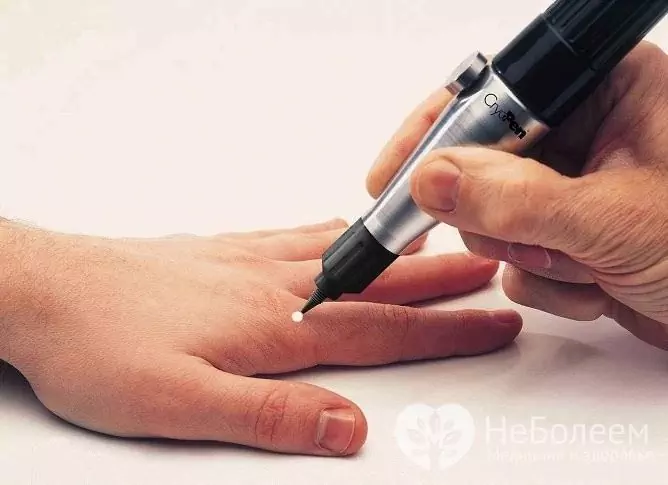
In children, warts are removed mainly by cryodestruction
The method of electrocoagulation consists in the action of an electric current on a neoplasm, which leads to tissue coagulation. Electrocoagulation is performed under local anesthesia using a surgical coagulator. The method avoids bleeding and the spread of infection. A crust remains at the site of the removed wart, which disappears within a week. When a large wart is removed by electrocoagulation, a small scar may remain in its place. Electrocoagulation is not suitable for removing large warts.
Cryotherapy consists of exposing the neoplasm to liquid nitrogen. The exposure time depends on the size of the tumor. Usually several cryodestruction sessions are required with 3-5 day intervals between them. Removal of warts in children by cryodestruction has the advantage of painlessness, absence of scars after treatment.
Laser therapy is used to treat warts in children that do not respond well to other methods. The procedure is performed under local anesthesia and consists of removing the wart layer by layer. The advantage of laser therapy is the absence of scars and pigmentation of the skin after the treatment, as well as the low probability of relapse. At the site of the removed neoplasm, a depression remains, which drags on for 1.5-2 weeks.
If it is impossible to remove a wart from a child by other methods, surgical resection is performed. Surgical treatment of warts in children requires local anesthesia. The base of the wart can be destroyed using cryosurgical techniques or an electric needle. Intradermal cosmetic sutures, which are applied using an atraumatic needle, are removed 7-10 days after the operation, subsequently a small light scar remains in this place.
Conducting a histological laboratory examination of the removed material is mandatory.
In some cases, especially with frequent relapses or a large affected area, as well as with laryngeal papillomatosis, surgical intervention is combined with antiviral therapy.
To prevent the spread of the pathological process to unaffected areas of the skin, local antiviral drugs are used.
Recurrences of warts in children are observed in about 25% of cases.
Possible complications and consequences
Complications of warts in children are found only with their frequent injury. It can be bleeding, soreness, the addition of a secondary bacterial or fungal infection with the development of an inflammatory process, in rare cases, malignant transformation is possible.
Forecast
The prognosis is favorable, in the vast majority of cases of warts in children, their self-resolution occurs.
Prevention
Primary prevention of the disease is to prevent infection with the human papillomavirus.
In order to prevent warts in children, it is recommended:
- antiseptic treatment of wounds and cuts on the skin;
- compliance with the rules of personal hygiene;
- strengthening the immune system (good nutrition, avoiding mental stress, etc.);
- using your own shoes in public places;
- avoiding wearing synthetic shoes.
YouTube video related to the article:

Anna Aksenova Medical journalist About the author
Education: 2004-2007 "First Kiev Medical College" specialty "Laboratory Diagnostics".
The information is generalized and provided for informational purposes only. At the first sign of illness, see your doctor. Self-medication is hazardous to health!


